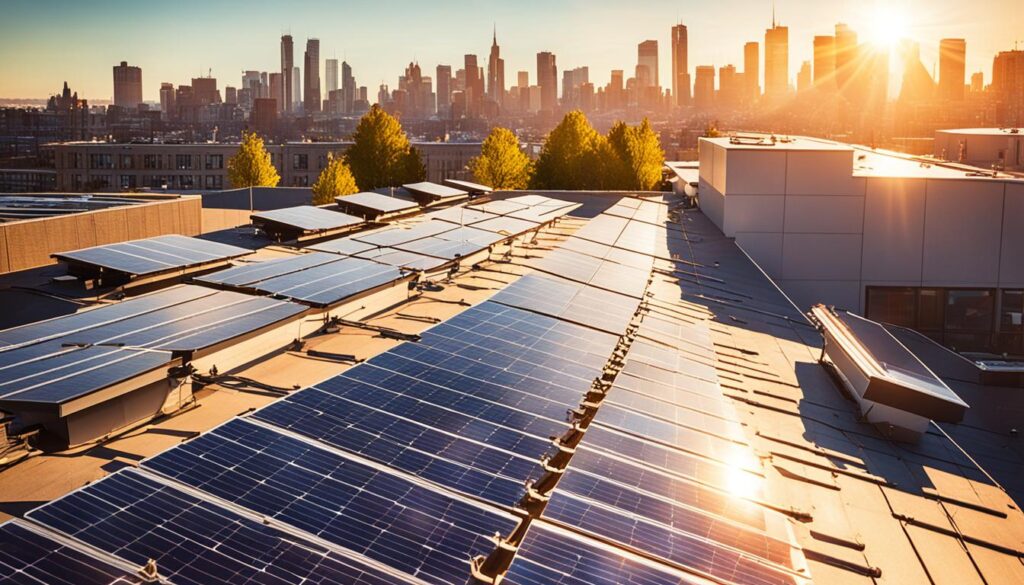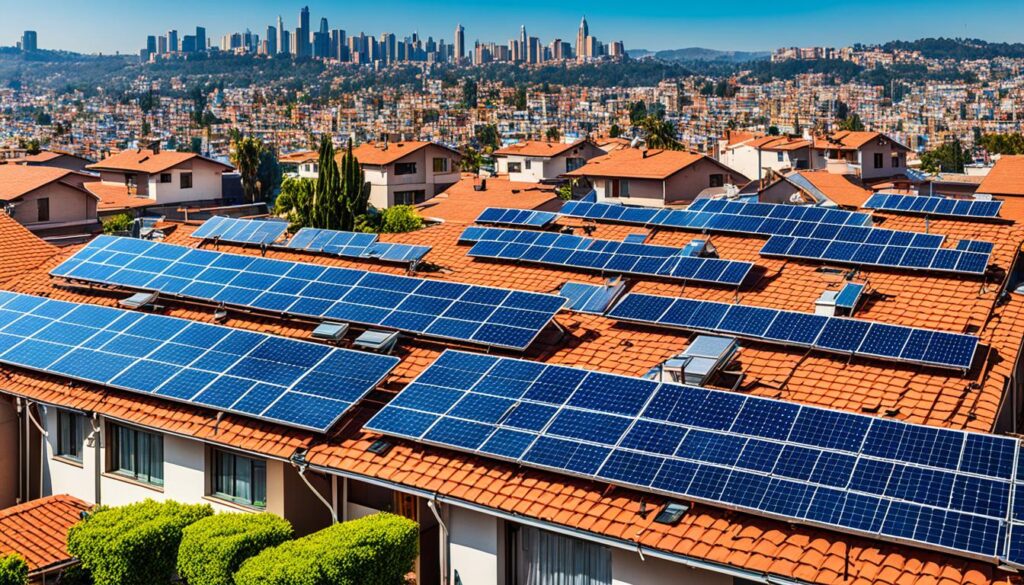India’s solar rooftop government yojana for 2024, known as the PM Surya Ghar Muft Bijli Yojana, is a scheme aimed at promoting the installation of rooftop solar panels in residential houses. The scheme offers subsidies and incentives to encourage the use of solar energy for electricity, leading to cost savings for households. This article provides an overview of the scheme, including its rationale, launch, subsidies, and projected impact on households and government expenditure.
Key Takeaways:
- The solar rooftop government yojana in India-2024, known as the PM Surya Ghar Muft Bijli Yojana, promotes the installation of rooftop solar panels in residential houses.
- The scheme offers subsidies and incentives to encourage the use of solar energy for electricity, leading to cost savings for households.
- The rationale behind the scheme is to promote sustainable energy practices, increase the use of renewable energy, and reduce carbon emissions.
- The scheme includes substantial subsidies provided by the government to cover a portion of the installation costs.
- The installation of rooftop solar panels not only leads to savings on electricity bills but also contributes to a greener and cleaner environment.
Understanding the Solar Rooftop Government Yojana
The Solar Rooftop Government Yojana, also known as PM Surya Ghar Muft Bijli Yojana, was launched in India in 2024 as part of a budget announcement. The scheme aims to provide subsidies for installing rooftop solar panels in residential houses, enabling households to generate their own electricity and reduce their reliance on traditional energy sources.
Rationale Behind the PM Surya Ghar Muft Bijli Yojana
The rationale behind the Solar Rooftop Government Yojana is to promote sustainable energy practices, increase the use of renewable energy, and reduce carbon emissions. By incentivizing the installation of rooftop solar panels, the government aims to harness the power of solar energy and create a more environmentally friendly and energy-efficient future.
The Launch and Subsidies
The launch of the Solar Rooftop Government Yojana includes substantial subsidies provided by the government to cover a portion of the installation costs. These subsidies aim to make rooftop solar panels more affordable and accessible for households across India. By reducing the upfront costs, the scheme encourages more homeowners to adopt solar energy and contribute to the country’s renewable energy goals.
Projected Impact on Households and Government Expenditure
The Solar Rooftop Government Yojana is expected to have a significant impact on households and government expenditure. By installing rooftop solar panels, households can generate their own electricity, leading to substantial savings on monthly electricity bills. Additionally, the scheme reduces the burden on the government to supply electricity to every household, which in turn lowers government expenditure on electricity costs.
The image below demonstrates the projected impact of the Solar Rooftop Government Yojana on households and government expenditure:
| Impact | Households | Government |
|---|---|---|
| Savings | Significant reduction in electricity bills | Lower expenditure on electricity supply |
| Empowerment | Ability to generate own electricity and become self-reliant | Less pressure on the government to provide electricity |
| Sustainable Future | Contribution to reducing carbon emissions | Promoting sustainable energy practices |
Comprehensive Benefits of Rooftop Solar Incentives
The Solar Rooftop Government Yojana offers a range of comprehensive benefits and incentives that make installing rooftop solar panels an attractive option for households. These incentives not only contribute to cost savings but also promote sustainability and provide additional opportunities for individuals and communities.
One of the primary benefits of the scheme is the potential for significant savings on electricity bills. By generating free solar electricity from rooftop panels, households can reduce their reliance on conventional energy sources and lower their monthly energy expenses. This not only puts more money back in their pockets but also helps to mitigate the impact of rising electricity costs.
Another advantage of the program is the opportunity to sell surplus solar power to electricity distribution companies. By connecting their panels to the grid, homeowners can feed excess energy back into the system. This not only helps to offset their own electricity consumption but also allows them to earn revenue by selling the surplus to the grid. It’s a win-win situation that not only benefits individual households but also contributes to the overall supply of clean and renewable energy.
The Solar Rooftop Government Yojana also encourages the use of solar power for charging electric vehicles (EVs). As the popularity of EVs continues to rise, the scheme provides a convenient and eco-friendly solution for EV owners. By utilizing solar power to charge their vehicles, owners can reduce their carbon footprint and contribute to the fight against climate change. This additional benefit aligns with the government’s efforts to promote sustainable transportation options and reduce air pollution.
Furthermore, the scheme creates entrepreneurial and employment opportunities in the solar energy sector. The installation, maintenance, and servicing of rooftop solar panels require a skilled workforce. As more households adopt solar energy through the yojana, the demand for solar professionals increases, leading to job creation and economic growth in the renewable energy sector.
The comprehensive benefits offered by the Solar Rooftop Government Yojana demonstrate its potential to transform India’s energy landscape. By incentivizing the installation of rooftop solar panels, the scheme promotes financial savings, reduces dependence on traditional energy sources, supports the growth of clean transportation, and stimulates economic development in the solar industry.

| Benefits of Rooftop Solar Incentives |
|---|
| Savings on electricity bills |
| Opportunity to sell surplus power |
| Charging electric vehicles using solar power |
| Entrepreneurial and employment opportunities |
Eligibility Criteria and the Application Process for Solar Subsidy Scheme
To avail the benefits of the Solar Subsidy scheme applicants need to meet certain eligibility criteria. These criteria include:
- Being a resident of India
- Belonging to a poor or middle-income household
- Having a suitable roof for installing solar panels
- Having a valid electricity connection
This section provides a step-by-step guide on the application process:
- Register on the official website of the Solar Rooftop Government Yojana
- Select the state and electricity distribution company
- Provide necessary details, such as contact information and roof specifications
- Wait for feasibility approval from the authorities
Supporting documentation is required during the application process. Applicants must provide proof of identity, proof of address, and a recent electricity bill. These documents help verify the applicant’s eligibility and assess the feasibility of installing solar panels on their rooftop.
Image for Reference:
Solar Rooftop Government Yojana: Installation Subsidy Breakdown
The Solar Rooftop Government Yojana provides installation subsidies based on the capacity of the rooftop solar system. The subsidy structure varies depending on the size of the solar capacity, ensuring that households of different needs can benefit from the scheme.
Subsidy Structure Across Different Solar Capacities
Under the Solar Rooftop Government Yojana, the subsidy structure is categorized based on different solar capacities:
| Solar Capacity | Subsidy |
|---|---|
| Up to 2 kW | 30000 per Kw |
| Additional capacity up to 3 kW | 18000 per kW |
| Systems larger than 3 kW | 78000 Fixed |
By offering varied subsidies across different solar capacities, the yojana ensures that households of all sizes can afford and benefit from solar energy installations.
Calculating Your Potential Savings
If you’re considering installing rooftop solar panels under the rooftop solar policy, calculating your potential savings can help you make an informed decision. To estimate your savings, consider factors such as your current electricity consumption, the capacity of the solar system you plan to install, and the prevailing electricity rates. The installation of solar panels can significantly reduce your monthly electricity bills, providing long-term financial benefits.
Additional Benefits for Group Housing Societies and RWAs
The Government solar scheme also offers additional benefits for Group Housing Societies and Resident Welfare Associations (RWAs). These benefits include:
- Subsidies for installing solar panels on common facilities, such as parking areas, community halls, and swimming pools.
- Subsidies for implementing electric vehicle charging infrastructure within the premises.
By extending these benefits to group housing societies and RWAs, the yojana encourages a collective shift towards renewable energy, fostering sustainability and reducing carbon footprints at a larger scale.
Conclusion
The Solar Rooftop Government Yojana is a remarkable initiative in India aimed at promoting the widespread adoption of solar energy and reducing reliance on traditional energy sources. Through its well-designed subsidies, incentives, and comprehensive benefits, the scheme strives to make solar energy accessible, affordable, and sustainable for households across the country.
By incentivizing the installation of rooftop solar panels, the yojana for solar rooftop not only helps households save on their electricity bills but also effectively contributes to a greener and cleaner environment. The use of solar energy reduces carbon emissions and helps combat climate change, making a positive impact on both individuals and the nation as a whole.
In India’s transition towards a sustainable energy future, the Solar Rooftop Government Yojana plays a crucial role. It empowers households to generate their own clean energy, reduces their dependence on the grid, and mitigates the strain on traditional energy resources. Furthermore, this initiative aligns with the country’s commitment to achieving its renewable energy targets and fostering a more sustainable, resilient future.
As the Solar Rooftop Government Yojana continues to gain momentum, it is expected to drive a significant shift in the energy landscape of India. It holds the potential to bring about a transformative change by harnessing the power of solar energy and enabling households to contribute actively to India’s clean energy goals. Through this scheme, the Indian government has taken a commendable step towards a brighter and more sustainable future.
FAQ
What is the Solar Rooftop Government Yojana?
The Solar Rooftop Government Yojana, also known as PM Surya Ghar Muft Bijli Yojana, is a scheme launched by the Indian government in 2024 to promote the installation of rooftop solar panels in residential houses.
What is the rationale behind the PM Surya Ghar Muft Bijli Yojana?
The scheme aims to promote sustainable energy practices, increase the use of renewable energy, and reduce carbon emissions by enabling households to generate their own solar electricity and reduce their reliance on traditional energy sources.
What subsidies are provided under the Solar Rooftop Government Yojana?
The government provides substantial subsidies to cover a portion of the installation costs of rooftop solar panels in residential houses.
How does the Solar Rooftop Government Yojana benefit households?
The benefits of the yojana include savings on electricity bills by generating free solar electricity, the opportunity to sell surplus power to electricity distribution companies, and the ability to charge electric vehicles using solar power.
Who is eligible for the Solar Rooftop Government Yojana?
To be eligible, applicants need to be residents of India, belong to a poor or middle-income household, have a suitable roof for installing solar panels, and have a valid electricity connection.
What is the application process for availing the Solar Rooftop Government Yojana?
The application process involves registering on the official website, selecting the state and electricity distribution company, providing necessary details, and waiting for feasibility approval. Supporting documentation, such as proof of identity, proof of address, and an electricity bill, is also required.
How are the installation subsidies under the scheme structured?
The installation subsidies are based on the capacity of the rooftop solar system. There are different subsidy structures for solar capacities up to 2 kW, additional capacity up to 3 kW, and systems larger than 3 kW.
What benefits are provided for Group Housing Societies and Resident Welfare Associations (RWAs)?
Group Housing Societies and RWAs are eligible for subsidies for common facilities and electric vehicle charging, in addition to the subsidies provided for individual rooftop solar installations.Offered subsidy for GHS and RWA is 18000 Per kW (Upto 500kW)

